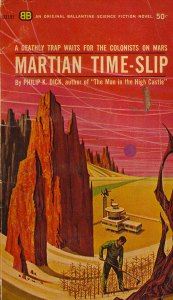Martian Time-Slip is maybe Philip K. Dick’s most focused examination of his malaise about the status of the American frontier. In other novels, the frontier was one of many settings, or a backdrop them. The typical frontier situation in a Philip K. Dick novel is set on a world in the solar system, often populated by conscripts or economic refugees (Zygmunt Bauman’s “Wasted Lives”). The frontier tended to resemble the California suburbs where Dick spent the greater part of his life. I am convinced that Dick often looked around his neighborhoods and pondered the fate of the great American frontier. It is unlikely that he would have been immune from the stories of the frontier so popular as part of America’s “victory culture.” Westerns and Davy Crockett programs flooded the televisions in the 1950s and they all proclaimed the greatness of the American frontier. The reality of conspicuous consumption, devastated landscapes, and cookie-cutter homes stood in stark contrast to the myth of the frontier that was so powerful for Americans. With no small degree of sadness, Dick could never fail to see a future frontier in space as a crude continuation of this. Dick comes the closest as he ever will in explaining the reason the frontier will inevitably suck.
The plot of Martian Time-Slip concerns a land speculation scheme, tensions over water-use between the settlers and the native population (another thing reflective of America’s over-developed frontier), an autistic child who can time-shift and learns to manipulate these shifts, and a whole host of marital infidelities. Not atypical of Dick’s work from the mid-sixties, marital infidelity and commitment are major themes. One interesting theory put forth is that mental illness is actually a different conception of time. This does not in itself undermine Dick’s broader point that we are all on a path toward mental illness. In a liquid world, time itself is more fluid. Perhaps it is our inability to synchronize our various clocks that make everyone look insane to us. But for now, I am concerned with the nature of the frontier and the reason for its sorrows.
The story opens with a housewife taking drugs to get through boring days with an absent husband. By the end of the novel, adultery will help waste the time, but for now the character mopes. “Feeling more and more guilty, she filled a glass with water in order to take her morning pill. If only Jack were home more, she said to herself; it’s so empty around here. It’s a form of barbarism, this pettiness we’re reduced to. What’s the point of all this bickering and tension, this terrible concern over each drop of water, that dominates our lives? There should be something more. . . We were promised so much, in the beginning.” It is likely that settlement was a bad idea to begin with. There is little evidence that Mars is suitable for habitation (at least in the novel’s universe). Like the residents of Chicken Pox Prospect in The Three Stigmata of Palmer Eldritch, most of the time is spent keeping equipment working, growing crops, and maintaining sanity through whatever external pleasure they can find.
Dick blames three sources for the poor conditions on Mars. The people themselves are not horrible. Again, as in Chicken Pox Prospect, there is a real effort at community. Solidarity indeed exists. The main character, Jack Bohlen, continually shows his capacity for self-sacrifice by sharing his skills with neighbors and even the native “Bleekmen.” Instead, it is capitalist speculation, the machinations of the state, and racism toward the native people that degraded conditions on Mars. In the vast majority of Dick’s work, even if the nature of reality is flexible, changing, or uncertain, the enemy is usually clearly identified. The ones sustaining the empire of lies always come from the powerful. In this novel, it is not lies they are after, but rather a brutal exploitation of a vulnerable settler population.
Starting with racism, we wonder if Dick modeled the Martian racial policy on South Africa or the Australian outback. As one character complains, the U.N. attempted to impose some more benevolent policies, energizing settler resistance. “However, we have this problem that we can’t pay any minimum wage to the Bleekmen niggers because their work is so inconsistent that we’d go broke, and we have to use them in mining operations because they’re the only ones who can breather down there.” This settler hostility to the native population seems to be a byproduct of the exploitation of the massive landowners and the Earth government, which would like to see the colony turn a profit. The U.N. is able to sustain its control through the supply of water to the colonies. This is actually quite tragic because the natives understand well how to make use of the local environment. As a servant of a major character shows more than once, his knowledge of the land and its powers had the potential to create a more prosperous colony. However, the Bleekmen were systemically destroyed or enslaved for tasks like mining, which had only an extractive purpose, benefiting no one who actually lived on Mars.
Not only is this traumatic for the Bleekmen, it destroys knowledge. As one reminded the settlers, “Formerly, when one wanted water, one pissed on the water witch, and she came to life. Now we do not do that, Mister; we have learned from you Misters that to piss is wrong. So we spit on her instead, and she hears that , too, almost as well. It wakes her, and she opens and looks around, and then she opens her mouth and calls the water to her.” The U.N. was part of a civilizing mission, but that mission seems to have undermined one of the traditional ways the native Martians acquired their water. Rather than tapping into this indigenous system, the settlers were bound to the oppressive and extractive U.N. apparatus.
It seems to me that in this world, the regimen of racial domination is largely a byproduct of other external forces. The end of the novel suggests hope for a new relationship with the Bleekmen, thanks to the autistic time-slipper. However, the overall power structure that seems to inadvertently caused the near genocide of the native people remains in place. From Dick’s perspective, it seems that the Bleekmen and settlers have much in common and would benefit from rethinking their relationship.







